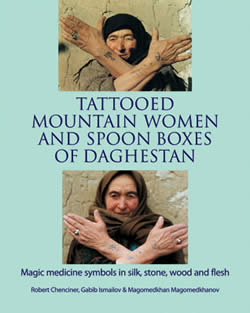TATTOOED MOUNTAIN
WOMEN AND SPOON BOXES OF DAGHESTAN: MAGIC MEDICINE SYMBOLS IN SILK, STONE, WOOD AND
FLESH
by Robert Chenciner, Gabib
Ismailov & Magomedkhan Magomedkhanov
 BOOK REVIEW BY LARS KRUTAK BOOK REVIEW BY LARS KRUTAK
Tattooed Mountain Women and Spoon Boxes of Daghestan: Magic
Medicine Symbols in Silk, Stone, Wood and Flesh (Bennett & Bloom, £19.99) is a fascinating new account of the understudied topic of indigenous tattooing practices in the Russian republic of Daghestan. Where is Daghestan you may ask? Well, it sits at the crossroads of two continents - Europe and Asia - and is wedged between the Black and Caspian Seas. Amidst the high peaks of the Great Caucasus Mountain Chain, Daghestan is a place that has bore witness to the legendary likes of Jason and the Argonauts, the Golden Fleece, the Amazons, and historic peoples including the Romans, Scythians, Christians, Huns, Persians, Arabs, Egyptian Copts, Mongols, and Ottoman Turks who have left their own indelible mark on the many artistic traditions of the region: including weaving, wood and stone carving, and tattooing.
Today, Daghestan is the home of some 109 tattooed women from 19 mountain villages who have kept the tattoo tradition alive. Here, perched beneath the majestic Caucasus, lie ancient villages where Islamic peoples worship nature as a form of animistic belief and women wear tattoos or "magic medicine symbols" that are believed to protect the hearth and the family from unseen spiritual forces that inhabit the remote alpine landscape.
Three regional experts - Robert Chenciner, Gabib Ismailov, and Magomedkhan Magomedkhanov - have spent over a decade recording and photographing this fascinating system of tattooing "to reveal the living vocabulary of this hidden body language."
The book begins with an overview of the various cultures and peoples that have called Daghestan home; the history of tattooing in and around Daghestan; local methods of tattoo application including pigments used; and the types, kinds, and distribution of traditional tattoo designs throughout the region. Fully indexed, rigorously cited, and with numerous maps and more than 140 color photographs and 180 specially drawn illustrations by London tattooist Alex Binnie (Into You Tattooshop), Tattooed Mountain Women is an illuminating 95-page handbook that should find its way to even the most knowledgeable tattoo enthusiastís bookshelf.
Of course, this book
is not just about local tattooing practices (thatís just Part One!); itís
also about the use and incorporation of protective magical tattooing designs
in other forms of material culture like carved stone hearths, door frames,
wooden spoons and spoon boxes, and even giant festival round bread! As the
British publisher Bennett & Bloom state on their
homepage, their books are about linking peoples and cultures in interesting ways and this approach brings to mind one of my favorite art historical adages: "if you seek the springs of traditional art, be prepared to dig deep."
For this reviewer, the knowledge embodied in learning from that which gave rise to tattoos is as fascinating as it is ancient. And although only a handful of recent publications have focused on tribal tattoos and their global, if not encyclopedic, distribution (e.g., Maarten Hesselt van Dinterís World of Tattoo), few books have focused their attention towards the importance of indigenous tattooing from a cultural anthropological perspective: one that bases its facts on face to face encounters with living people in an ever-changing world and not on archival research alone. In this regard, I give Tattooed Mountain Women a big thumbs up.
Moreover, Tattooed Mountain Women is about, well, TATTOOED WOMEN! And to my knowledge, not one book has devoted its attention towards the importance of indigenous (tribal) womenís tattooing arts and the work female tattooists performed for their clients. This fact alone I find surprising, since according to my research I believe that over 60% of all indigenous tattooists working in the world were, at one time or another, women! The major exception to this rule was, of course, in Polynesia were men did most of the tattooing, although women did tattoo in some parts of Polynesia like Fiji.
So where can you purchase a copy of Tattooed Mountain Women? Your best bet is
www.amazon.com.uk or
www.asianstudiesbooks.com
because the publisher Bennett & Bloom has not yet penetrated American distribution channels (note: they are working to break this impasse). Although Bennett & Bloom is a small independent press, they are slowly expanding their lists. Perhaps uniquely, everyone is a working author at Bennett & Bloom and they have vast expertise in working with larger publishers. As one of their acquisitions editors told me, "It would also be a long cherished dream realized if people might one day soon think ĎAh, Bennett & Bloom - good for tattoos!í" And since they stand for getting books out quickly, with high quality at a comparatively reasonable price, perhaps this dream may soon come true.
Bennett & Bloom
Tattooed Mountain
Women and Spoon Boxes of Daghestan:
Magic Medicine Symbols in Silk, Stone, Wood and Flesh
Bennett & Bloom
PO Box 2131
London W1A 5SU, UK
|